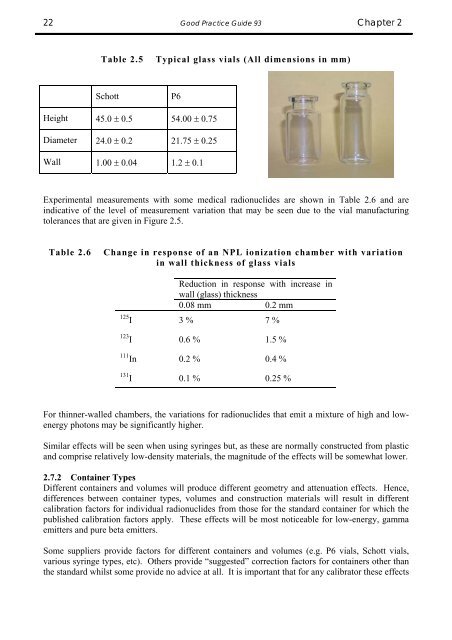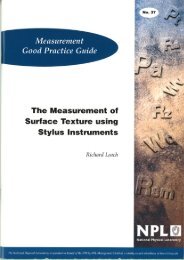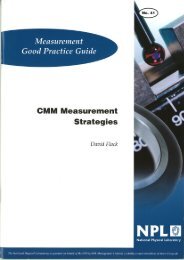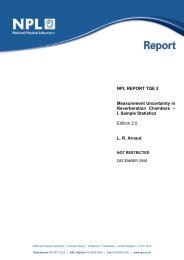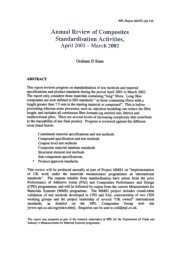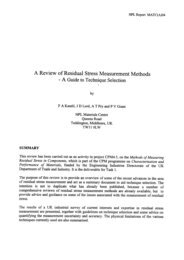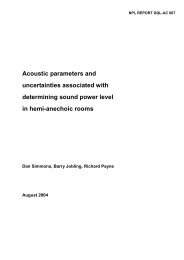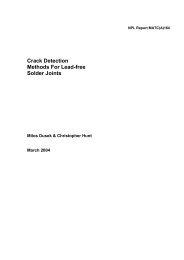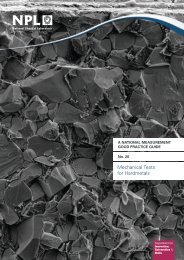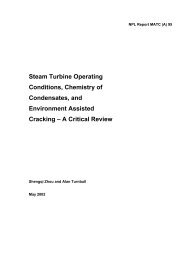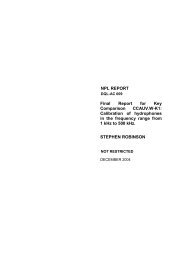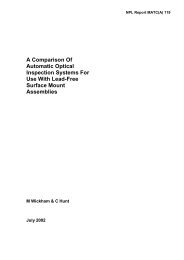Protocol for Establishing and Maintaining the Calibration - NPL ...
Protocol for Establishing and Maintaining the Calibration - NPL ...
Protocol for Establishing and Maintaining the Calibration - NPL ...
Create successful ePaper yourself
Turn your PDF publications into a flip-book with our unique Google optimized e-Paper software.
22 Good Practice Guide 93 Chapter 2<br />
Table 2.5<br />
Typical glass vials (All dimensions in mm)<br />
Schott<br />
P6<br />
Height 45.0 ± 0.5 54.00 ± 0.75<br />
Diameter 24.0 ± 0.2 21.75 ± 0.25<br />
Wall 1.00 ± 0.04 1.2 ± 0.1<br />
Experimental measurements with some medical radionuclides are shown in Table 2.6 <strong>and</strong> are<br />
indicative of <strong>the</strong> level of measurement variation that may be seen due to <strong>the</strong> vial manufacturing<br />
tolerances that are given in Figure 2.5.<br />
Table 2.6<br />
Change in response of an <strong>NPL</strong> ionization chamber with variation<br />
in wall thickness of glass vials<br />
Reduction in response with increase in<br />
wall (glass) thickness<br />
0.08 mm 0.2 mm<br />
125 I 3 % 7 %<br />
123 I 0.6 % 1.5 %<br />
111 In 0.2 % 0.4 %<br />
131 I 0.1 % 0.25 %<br />
For thinner-walled chambers, <strong>the</strong> variations <strong>for</strong> radionuclides that emit a mixture of high <strong>and</strong> lowenergy<br />
photons may be significantly higher.<br />
Similar effects will be seen when using syringes but, as <strong>the</strong>se are normally constructed from plastic<br />
<strong>and</strong> comprise relatively low-density materials, <strong>the</strong> magnitude of <strong>the</strong> effects will be somewhat lower.<br />
2.7.2 Container Types<br />
Different containers <strong>and</strong> volumes will produce different geometry <strong>and</strong> attenuation effects. Hence,<br />
differences between container types, volumes <strong>and</strong> construction materials will result in different<br />
calibration factors <strong>for</strong> individual radionuclides from those <strong>for</strong> <strong>the</strong> st<strong>and</strong>ard container <strong>for</strong> which <strong>the</strong><br />
published calibration factors apply. These effects will be most noticeable <strong>for</strong> low-energy, gamma<br />
emitters <strong>and</strong> pure beta emitters.<br />
Some suppliers provide factors <strong>for</strong> different containers <strong>and</strong> volumes (e.g. P6 vials, Schott vials,<br />
various syringe types, etc). O<strong>the</strong>rs provide “suggested” correction factors <strong>for</strong> containers o<strong>the</strong>r than<br />
<strong>the</strong> st<strong>and</strong>ard whilst some provide no advice at all. It is important that <strong>for</strong> any calibrator <strong>the</strong>se effects


